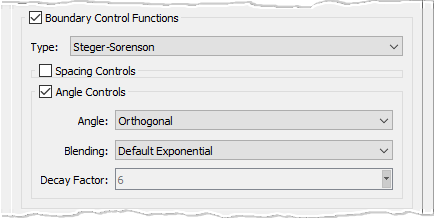Description
Angle refers to the angle that transverse grid lines make with the boundary.

Use the controls provided in the Angle Controls frame to specify how the Angle and the Blending of interior grid lines should be computed.
You can choose from four methods for computing the angle constraint:
- Orthogonal: Sets the angle constraint to 90 degrees. This is the default method.
- Interpolate: The angle control is computed by interpolating linearly from the perimeter of the boundary onto the interior. A simple linear basis is used for the interpolation.
- Current Grid: This maintains the angle currently in place in the grid.
- Adjacent Grid: The angle control is copied from another grid which is selected for the elliptic solver with the current grid and shares the selected boundary. If desired, changes in the adjacent grid can be prevented by setting a relaxation factor of 0.0 on the Attributes tab. If the adjacent grid cannot be determined (either if none exists or if more than one exists), the constraint is changed to Current Grid. This control provides angle continuity across grid boundaries.
Blending refers to the way in which the boundary control function merges with the interior control functions. The available choices are:
- Linear: The angle control is blended linearly from the boundary into the interior.
- Default Exponential: An exponential function is used to rapidly decay the angle constraint into the grid's interior. This is the default blending function type.
- Custom Exponential: This allows you to specify a Decay Factor, which is the number of grid points away from the boundary at which the angle control portion of the boundary control function will be equal to 10% of its boundary value. The default value is 6. Smaller values are more stable, but may dissipate the angle constraint too quickly. Negative decay values are not allowed.